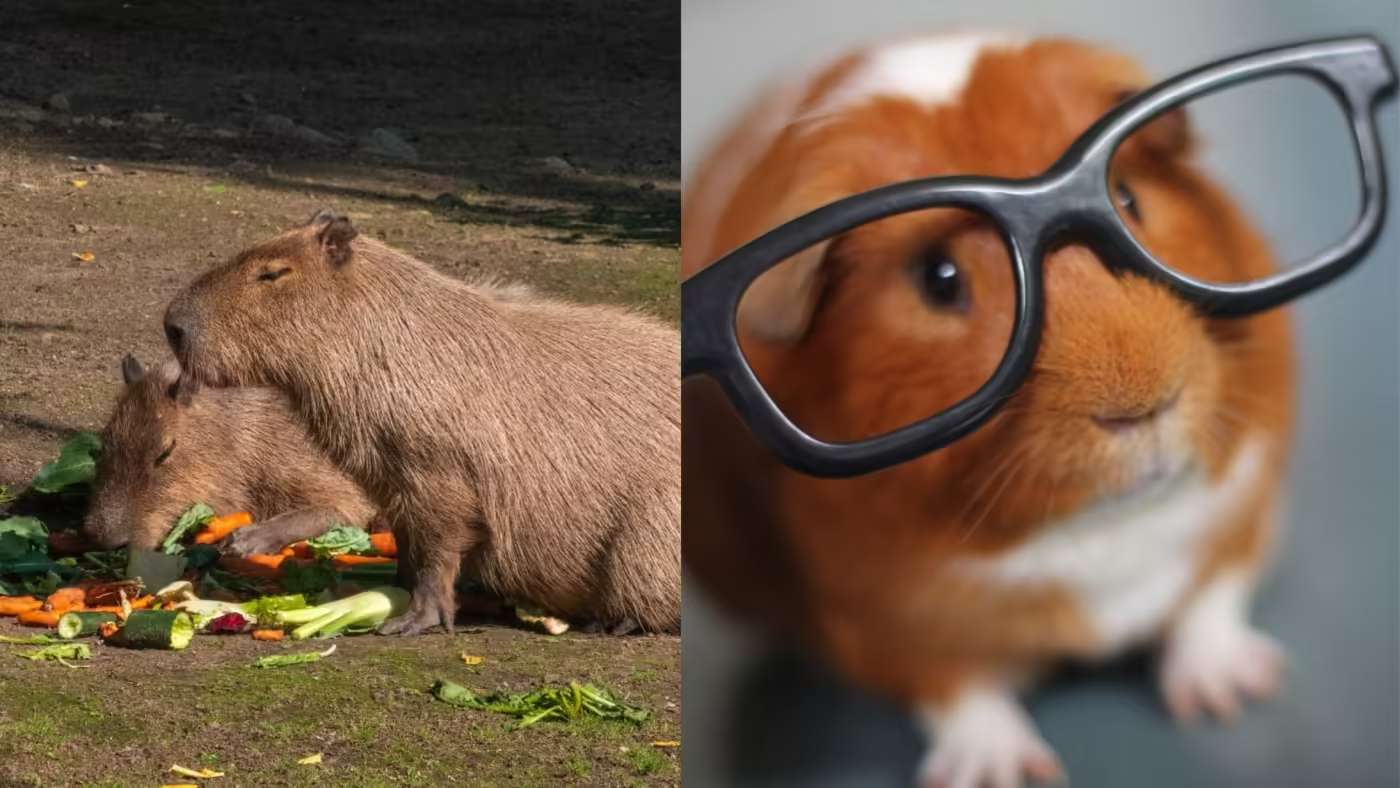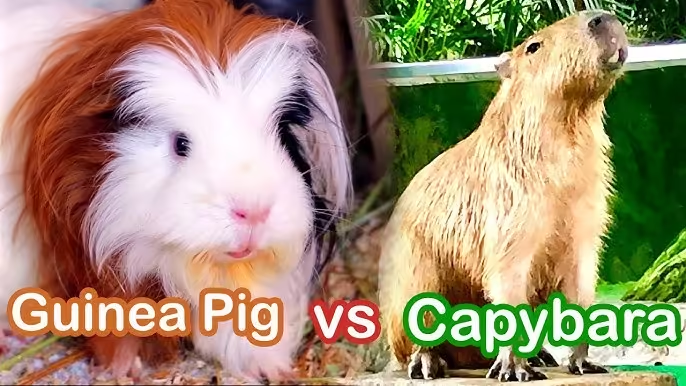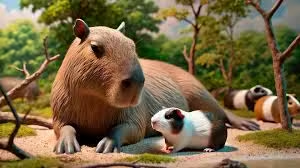Capybaras and guinea pigs belong to the rodent family but have different lifespans. Capybaras, the largest rodents, can live up to 8-10 years in captivity. On the other hand, guinea pigs usually live between 4-8 years. This article will look at what affects these pets’ lifespans, focusing on the main differences.
Key Takeaways
- Capybaras can live up to 8-10 years in captivity. In the wild, they face many dangers and live only about 4 years.
- Guinea pigs live between 4-8 years. Their diet, health care, and living conditions greatly affect how long they live.
- Capybaras in the wild are at risk from big cats, birds of prey, and other predators.
- Guinea pigs can get sick easily. They need a special diet to stay healthy.
- Both species have unique ways of living. Capybaras live in groups, while guinea pigs prefer to be alone.
Understanding Capybaras and Guinea Pigs: Basic Overview
Capybaras and guinea pigs belong to the Caviidae family. But they look and live in different ways. Capybaras are the biggest rodents, weighing about 50 kilograms. Guinea pigs are much smaller, weighing between 700-1,200 grams.
Physical Characteristics
Capybaras are big, semi-aquatic rodents. They are 39 to 51 inches long and 20 inches tall. They can run up to 35 kilometers per hour, as fast as a horse. Guinea pigs are much smaller, only 20-25 cm long.
Natural Habitat
Capybaras live in South America’s wetlands, rivers, and marshes. They often sleep in the water to stay cool. Guinea pigs come from the Andes mountains of South America.
Evolutionary Background
Capybaras and guinea pigs are both in the Caviidae family. But they are different genera. Capybaras are in Hydrochoerus, and guinea pigs are in Cavia. This difference shows in their looks and how they live.
| Characteristic | Capybara | Guinea Pig |
|---|---|---|
| Average Weight | 50 kg | 700-1,200 g |
| Average Length | 100-130 cm | 20-25 cm |
| Top Speed | 35 km/h | N/A |
| Habitat | South American wetlands | Andes mountains |
| Genus | Hydrochoerus | Cavia |
Do Capybaras Live Longer Than Guinea Pigs and Other Rodents?
Capybaras usually live longer than guinea pigs. While capybaras can live up to 8-10 years in the wild, guinea pigs live about 4-8 years. But, capybaras don’t have the longest lifespan among rodents.
Some rodents, like naked mole rats, beavers, and porcupines, can live over 20 years. On the other hand, mice and rats live less than 5 years. So, capybaras have a mid-range lifespan among rodents.
| Rodent Species | Average Lifespan |
|---|---|
| Naked Mole-rat | Over 20 years |
| Beaver | Over 20 years |
| Porcupine | Over 20 years |
| Capybara | 4-8 years (wild), up to 12 years (captivity) |
| Guinea Pig | 4-8 years |
| Mouse | Less than 5 years |
| Rat | Less than 5 years |
Even though capybaras don’t have the longest lifespan, they still live longer than guinea pigs. Learning about capybara longevity and guinea pig longevity helps us understand these interesting rodents better.
Factors Affecting Capybara Lifespan in the Wild
Capybaras, the world’s largest rodents, face many challenges in their natural habitats. These include environmental conditions, predation risks, and their social structure.
Environmental Conditions
Capybaras live in semi-aquatic environments, needing lots of water. They prefer rivers, lakes, and marshes. But, these places can have extreme weather, droughts, or floods.
These changes can make it hard for them to find food and water. This can shorten their lifespan.
Predation Risks
Capybaras are prey for many predators. Jaguars, caimans, and anacondas are among their biggest threats. They use their senses, agility, and social behavior to avoid predators.
But, the risk of being hunted is always there. This makes their survival a big challenge.
Social Structure Impact
Capybaras live in groups of 10 to 20. This social structure helps protect them. They can watch for threats and share resources together.
But, their social dynamics can also affect their lifespan. Competition for resources and breeding can cause stress. This stress can impact their health and longevity.
In conclusion, capybara lifespan in the wild is influenced by many factors. Environmental conditions, predation risks, and social structure all play a role. Understanding these factors helps us appreciate their challenges and supports conservation efforts.
Guinea Pig Longevity: Key Factors
Guinea pigs’ lifespan is affected by many things. These include their diet, where they live, their genes, and their health. In homes, they can live up to 8 years if cared for well. But, there are important things that pet owners need to focus on.
What guinea pigs eat is very important for their health and how long they live. Since they can’t make vitamin C, they need it from food or supplements. Eating foods rich in fiber, proteins, and vitamins helps keep them healthy.
- Guinea pigs need a lot of vitamin C because they can’t make it themselves.
- Eating a mix of hay, fresh veggies, and special guinea pig food helps them live longer.
- It’s important to change their diet to fit what each guinea pig needs to stay healthy.
The place where guinea pigs live and the care they get also affects how long they live. They need lots of space, the right environment, and friends to be happy and healthy.
- Having a big, nice place to live with the right temperature, humidity, and light helps them feel less stressed.
- Going to the vet regularly and getting care like dental trims helps find and fix health problems early.
- Creating a loving, calm home with positive training and socializing helps them live longer and happier.
By knowing what affects how long guinea pigs live and taking good care of them, owners can help them live long, happy lives. It’s all about giving them a good diet, a nice home, and great vet care.
Health and Disease Comparison
Understanding the health of capybaras and guinea pigs is key. Capybaras face issues like parasitic infections and dental problems. Guinea pigs deal with respiratory infections, dental issues, and vitamin C deficiency. Both need regular vet visits, proper food, and clean homes to stay healthy.
Common Health Issues
Capybaras often get tick-borne diseases and intestinal parasites. They also have dental problems because their teeth keep growing. This can cause pain and eating troubles if not treated.
Guinea pigs are at risk for respiratory infections like pneumonia. They also face dental issues and vitamin C deficiency, leading to scurvy and other health problems.
Preventive Care Requirements
- Regular veterinary check-ups to monitor for any signs of illness or disease
- Proper diet, including a balanced and vitamin-rich diet for both species
- Maintaining a clean and well-ventilated living environment to reduce the risk of respiratory infections and other health issues
- Dental care, such as trimming their continuously growing teeth, to prevent dental problems
- Parasite prevention and control measures, such as regular deworming and tick prevention
Knowing the health concerns of capybaras and guinea pigs helps owners keep them healthy. With the right care, these rodents can live long, happy lives.
Diet Impact on Lifespan
Good nutrition is key for both capybaras and guinea pigs to stay healthy and live long. Capybaras eat grasses and plants from water. Guinea pigs need hay, veggies, and vitamin C to stay healthy.
Capybaras eat their own poop to get more nutrients. This helps them stay healthy. Guinea pigs eat a variety of foods to get what they need.
| Nutrient Requirements | Capybaras | Guinea Pigs |
|---|---|---|
| Protein | Elderly capybaras may need more protein to keep muscles strong. | Guinea pigs need lots of protein for fast growth. |
| Vitamins and Minerals | Capybaras get vitamins and omega-3s for better health as they age. | Older guinea pigs need vitamin C to stay healthy. |
| Feeding Frequency | Capybaras in captivity might need to eat more often. Older ones eat less at a time. | Guinea pigs eat hay, veggies, and a bit of pellets or blocks. |
Knowing what capybaras and guinea pigs need to eat helps them stay healthy. This is true whether they live in the wild or in captivity.
Living Conditions and Care Requirements
It’s important to make sure both capybaras and guinea pigs have the right living conditions. They need different spaces, environments, and social settings to stay healthy and happy.
Space Needs
Capybaras, being the world’s largest rodents, need lots of outdoor space and water for swimming. They do best in big, natural areas that feel like home. Guinea pigs, on the other hand, need big cages or pens. These should have lots of room for them to move, hide, and climb.
Environmental Controls
Keeping the right temperature is key for both capybaras and guinea pigs. Capybaras can’t handle too much heat or cold. Guinea pigs also need a steady, comfortable temperature to stay healthy. Keeping their living areas clean and well-ventilated is also important.
Social Needs
Capybaras love to live in groups, just like in the wild. It’s important to let them interact and form their own social order. Guinea pigs also do well in pairs or small groups. Their social needs should be thought of when deciding how to house them.
Meeting the specific needs of capybaras and guinea pigs is vital for their health and happiness. By considering their unique needs for space, environment, and social interaction, we can create a great home for these interesting rodents.
| Feature | Capybara | Guinea Pig |
|---|---|---|
| Space Needs | Require large, outdoor enclosures with access to water for swimming | Need spacious cages or pens with ample room for exercise and hiding spots |
| Environmental Controls | Sensitive to extreme heat and cold, require temperature regulation | Require stable, moderate temperature and good ventilation |
| Social Needs | Highly social, live in large groups in the wild | Thrive in pairs or small groups |
Breeding and Reproduction Effects on Longevity
Capybaras, the world’s largest rodents, breed all year round. They have a gestation period of 130 to 150 days. Their litters usually have 2 to 8 pups.
Guinea pigs, on the other hand, have a shorter gestation period of 59 to 72 days. They give birth to smaller litters, with 1 to 6 pups.
These reproductive differences can affect the longevity of both capybaras and guinea pigs. Frequent breeding is physically demanding for females. It can shorten their lifespan.
The energy needed to raise multiple offspring is a strain. This can impact the longevity of capybara breeding and guinea pig reproduction.
The rodent mating dynamics also play a role. Dominant animals often have better resources and less stress. This can lead to a longer lifespan for them.
Understanding these relationships is key to ensuring the health and well-being of these rodents. It helps in promoting their longevity.



